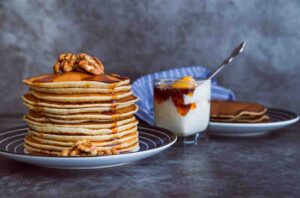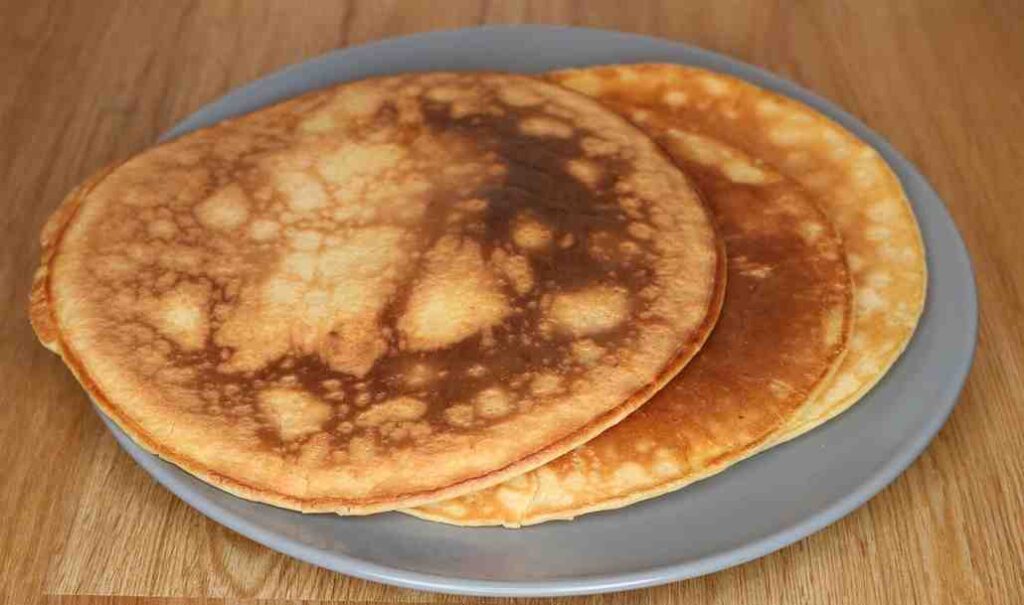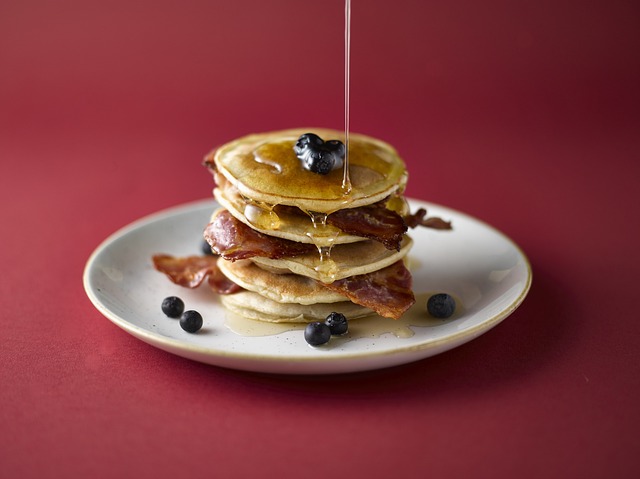Pancakes are a universal breakfast favorite, cherished for their soft texture and versatility. Whether you like them drizzled with maple syrup, covered in fruit, or even enjoyed plain, there’s no denying their appeal. But what if we told you there’s a simple way to make your boxed pancake mix even better?
Buttermilk offers a tangy depth that water simply can’t match, and it produces fluffier, more tender pancakes. In this article, we’ll explore the reasons why buttermilk is a superior choice, the science behind the substitution, and provide you with expert tips and recipe variations to perfect your next batch of pancakes.
Why Buttermilk Beats Water for Pancakes
The Flavor Transformation
Buttermilk elevates your pancakes by adding a rich, tangy flavor and improving their texture. Its unique properties bring a depth of flavor and balance that water simply cannot achieve.
- Perfect Balance: It complements sweet add-ins like berries or chocolate without overpowering them.
- Enhanced Flavor: Buttermilk’s subtle tanginess balances the sweetness of toppings like syrup or fruit.
- Improved Texture: The acidity reacts with baking soda or baking powder, creating a fluffier and more tender pancake.
Fermentation Benefits: Buttermilk’s slight tartness enhances the overall taste profile of your pancakes.

Fluffiness and Texture
For light, fluffy pancakes, buttermilk is an essential ingredient that transforms the texture and flavor of your breakfast.
- Improved Results with Boxed Mix: Adding buttermilk to pancake mix yields noticeable improvements over water, delivering a fluffier and tastier breakfast.
- Fluffier Texture: The acid in buttermilk reacts with baking soda and leavening agents, creating carbon dioxide bubbles that make pancakes rise.
- Rich Consistency: Buttermilk’s thicker texture creates a denser, more satisfying pancake compared to water.
- Enhanced Flavor: The slight tang of buttermilk gives pancakes a fuller, more balanced taste.
Richness and Tenderness
Buttermilk creates soft, tender pancakes by adding fat and protein that water cannot provide. Its acidity and richness improve the batter, resulting in light, airy pancakes with a luxurious texture.
- Gourmet Upgrade: Transforms boxed mix into a homemade-style breakfast treat.
- Tender Crumb: Adds proteins that create a soft, melt-in-your-mouth structure.
- Richness Without Heaviness: Minimal fat enhances flavor without weighing down the pancakes.
Perfect Balance: Acidity helps the batter rise and balances the flavor for a satisfying bite.
How to Substitute Buttermilk in Box Pancake Mix

The Simple Swap
Replacing water with buttermilk in a boxed pancake mix is an easy trick to elevate your breakfast. Simply substitute the water with an equal amount of buttermilk—no additional adjustments needed.
Balancing the Thickness
Since buttermilk is thicker than water, your batter might feel more viscous. To adjust, add a tablespoon or two of extra liquid (buttermilk or water) to achieve your preferred consistency while keeping the batter thick enough for fluffy pancakes.
Adjusting the Fat Content
Buttermilk’s natural fat enhances the richness of pancakes, meaning you can reduce or skip the oil or butter in your mix. Experiment with cutting the added fat in half to maintain tender, flavorful pancakes without heaviness.
The Science Behind Buttermilk Pancakes
Acidity and Leavening Agents
Buttermilk’s acidity is key to creating fluffy, flavorful pancakes. Its interaction with leavening agents like baking soda triggers a chemical reaction that releases carbon dioxide, forming bubbles in the batter that make the pancakes rise.
- Improved Structure: The proteins in buttermilk strengthen the batter, holding pancakes together during cooking.
- Chemical Reaction: The acidic buttermilk reacts with baking soda, creating carbon dioxide bubbles for a light, airy texture.
- Balanced Flavor: Buttermilk’s acidity neutralizes the alkaline taste of baking soda, enhancing the overall flavor.
Protein Content and Texture
Buttermilk’s proteins strengthen the batter, creating a soft, tender crumb that water cannot achieve. Its protein and acidity combination ensures a consistent, light, and satisfying texture.
- Hydration Plus Structure: Unlike water, buttermilk hydrates and contributes to the pancake’s structure.
- Stronger Batter: Proteins in buttermilk make the batter more elastic and uniform.
- Tender Crumb: Creates a soft, melt-in-your-mouth texture.
- Balanced Texture: Reduces dense or chewy spots for evenly light pancakes.
Homemade Buttermilk Pancakes
These homemade buttermilk pancakes are simple to prepare and yield soft, fluffy results every time. With basic pantry ingredients and straightforward instructions, this recipe is perfect for an easy breakfast or a leisurely weekend brunch.

Ingredients:
- 2 cups all-purpose flour
- 2 tablespoons granulated sugar
- 2 teaspoons baking powder
- 1/2 teaspoon baking soda
- 1/2 teaspoon salt
- 2 cups buttermilk
- 2 large eggs
- 1/4 cup melted butter, plus extra for cooking
- 1 teaspoon vanilla extract
Instructions:
- Prepare Dry Ingredients: In a large mixing bowl, whisk together the flour, sugar, baking powder, baking soda, and salt.
- Combine Wet Ingredients: In a separate bowl, beat the buttermilk, eggs, melted butter, and vanilla extract until well blended.
- Mix the Batter: Gradually add the wet ingredients to the dry ingredients, stirring gently until just combined. Avoid overmixing; some lumps are fine.
- Rest the Batter: Allow the batter to rest for 5-10 minutes to ensure a fluffier texture as the leavening agents activate.
- Cook the Pancakes: Heat a non-stick pan or griddle over medium heat. Lightly grease the surface with butter or oil. Pour 1/4 cup of batter for each pancake. Cook for 2-3 minutes, until bubbles form on the surface and the edges begin to set, then flip and cook for another 1-2 minutes until golden brown.
- Serve Warm: Serve immediately with butter, syrup, fresh fruit, or other desired toppings.
Tips for Success:
- Mixing the batter gently is crucial for maintaining a tender texture; overmixing can result in tougher pancakes.
- If the batter appears too thick, you can thin it slightly with an additional tablespoon or two of buttermilk.
- Keep pancakes warm in a 200°F oven while cooking in batches.
Buttermilk Pancake Variations to Explore
Lemon Zest Buttermilk Pancakes
Add lemon zest and a splash of fresh lemon juice to your buttermilk pancake batter for a bright, citrusy twist. Pair with fresh blueberries, powdered sugar, and honey for a vibrant brunch option.
Blueberry Buttermilk Pancakes
Fold fresh blueberries into your buttermilk batter for a sweet-tart flavor that complements the tanginess. Serve with warm maple syrup or whipped cream for a classic favorite.
Savory Buttermilk Pancakes
Transform your pancakes with chopped herbs, shredded cheese, and even crumbled bacon or sausage. Pair with eggs or avocado for a hearty, savory breakfast.
Cinnamon and Nutmeg Buttermilk Pancakes
Add warm spices like cinnamon and nutmeg to the batter. These aromatic spices pair beautifully with the tang of buttermilk, creating pancakes that are reminiscent of holiday treats.
Tips for Perfect Buttermilk Pancakes
Achieving perfect buttermilk pancakes is all about the right technique. Mix the batter gently, allow it to rest, and cook on medium heat for fluffy, tender results. Use the tips below to master your pancake game!
| Tip | Why It Matters | How to Do It |
|---|---|---|
| Mix Gently | Overmixing develops gluten, leading to tough pancakes. | Stir until ingredients are just combined; lumps are okay and will cook out. |
| Let Batter Rest | Resting allows flour to hydrate and leavening agents to activate, resulting in fluffier pancakes. | Let the batter sit for 5-10 minutes before cooking. |
| Use Medium Heat | Prevents burning and ensures even cooking. | Cook on medium heat; test with a small batter dollop to ensure it sizzles gently without smoking. |
| Keep Pancakes Warm | Prevents pancakes from getting cold while cooking in batches. | Place cooked pancakes on a baking sheet in a 200°F oven until ready to serve. |

